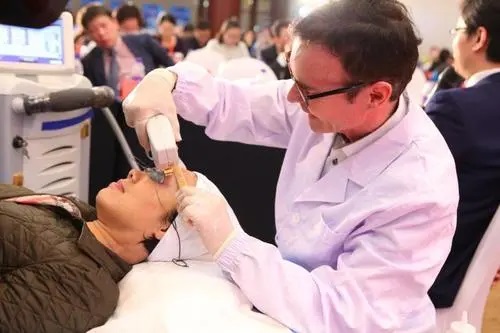High power Q-switched 1064nm/532nm Nd:YAG Laser in tattoo removal:
A systematic review (Part 1)
[Cited from: JOURNAL OF COSMETIC AND LASER THERAPY, Authors: Debora Aparecida Oliveira Modena, etc.]
Tattoos have been present in human culture since the beginning of civilization, being regarded as permanent signals with many meanings: amulets, symbols of status and religious beliefs and adornments, among others.
Tattoos can be divided into five categories: professional, amateur, traumatic, medical and cosmetic. Professional ones are carried out suing special equipment with vibrating needles containing inks of different colors, amateur ones are made with needles or improvised equipment and the ink is normally pen ink, coal, or soot. Traumatic tattoos occur when the ink is deposited onto the skin through abrasion or force resulting from an explosion. Medical tattoos are frequently used in radiotherapy protocols, and there are currently cosmetic tattoos that encompass the regions of the eyebrows, eyelids, lips, and the reconstruction of mammal areolas, among others.
However, any type of tattoo can cause complications or dissatisfaction, and even changes in self-perception can lead individuals to seek methods of tattoo removal. Techniques for tattoo removal have existed since 543 BC, initially developed by the Greeks, which carried out skin abrasion followed by the application of salts and chemical products.
The possibility of tattoo removal with lasers was described in 1965, with the use of the Q-switched Nd:YAG (www.wisoptic.com) laser by Goldman et al. By the end of the 1970s, studies started to appear and other types of lasers, such as carbon dioxide (CO2) and argon were reported; however, these lasers presented of unesthetic scar formation and hypopigmentation after their use.
In 1983, with the publication of the theory of selective photothermolysis, Q-switched 1064 nm/532 nm Nd:YAG lasers gained recognition due to the advantages they presented. That is , they were capable of destroying only specific targets, with minimal damage to the subjacent tissue. Three lasers operate in this manner, Ruby, Nd:YAG and Alexandrite, and the choice of laser used must take into consideration the physical aspects of the patient, such as the phototype, and the laser parameters, such as pulse duration, spot size, and fluence.
The Nd:YAG laser presents two wavelengths, 1064 nm, which emits infrared light, and 532 nm which emits green light. This green light is due to the non-linear effects of the promotion of twice the frequency of light, that is, half the wavelength of 1064 nm. This versatility in the wavelengths allows the Nd:YAG laser to treat dark inks, such as the black and dark blue inks, using 1064 nm and also the red, yellow, and orange inks with 532 nm.
The physiological effects of the Q-switched 1064 nm/532 nm Nd:YAG lasers include fragmentation of melanosomes and phagocytosis of the external ink, caused by the vibrational effect associated with the shockwave. That is, the molecules absorb the high energy in a short interval of time, in the order of ns (10 to 100ns), and thus an explosion occurs. From this, the agglomerates of inks are fragmented by a mechanism known as the photoacoustic mechanism. The pigment is dispersed in the extracellular space and ends up being removed by macrophages. This type of laser is the most commonly used on skin phototypes V and VI, because it presents the deepest power of penetration, reducing the risk of dyschromia, due to how the melanin absorbs the wavelength of this type of laser less.
In face of what has been exposed, we know there are numerous types of lasers capable of removing tattoos. However, there are only a few studies that make evident their real safety and efficacy, particularly regarding the skin phototype and the pigment used in the tattoo. Therefore, the objective of this study was to evidentiate the efficacy, benefits, and safety of the application of the Q-switched 1064 nm/532 nm Nd:YAG lasers and the possible adverse effects in the process of removing black and color tattoos.
Post time: Mar-12-2022

